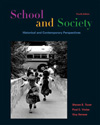 |  School and Society: Historical and Contemporary Perspectives, 4/e Stephen E. Tozer,
The University of Illinois, Chicago
Paul C. Violas
Guy Senese,
Northern Arizona University
Diversity and Equity Today: Meeting the Challenge
Learning ObjectivesChapter 13 provides the content and context to enable students to address the following questions:
| Do social inequalities and inequities determine, or just influence, unequal educational outcomes in schools today? The authors clearly believe that teachers and schools can have significant influence that resists the impact of social inequalities, but do you agree with this? |
 |  |  | | What sense can we make today of the famous classroom experiment by Jane Elliott, the discrimination day exercise? |
 |  |  | | Which main theories of social and educational inequality seem best to explain the data on social and educational differences described in Chapters 12 and 13? |
 |  |  | | To what degree does the "gender-sensitive" concept apply to race sensitivity or ethnicity sensitivity in the effort to respond to the needs of different kids? How similar are these ideas to "culturally responsive pedagogy"? |
 |  |  | | Are the Chapter 13 examples of successful learning by low-income and minority students applicable to other teaching settings? For example? |
 |  |  | | What different approaches to multicultural or anti-racist or culturally responsive pedagogy seem most valuable for achieving the national teaching standards described in Chapter 10? Explain why. |
|



 2002 McGraw-Hill Higher Education
2002 McGraw-Hill Higher Education